A dice drafting and resource management game of building the Temple of Amun-Ra and Ipet-Isut
60-120 minutes
Designer: Daniele Tascini, Dávid Turczi
Artist(s): Jakub Fajtanowski, Michał Długaj, Zbigniew Umgelter, Alexander Zawada
Publisher: Board & Dice
Disclaimer: It has recently come to light that designer Daniele Tascini has made both racist and sexist comments in interviews and in his personal social medias. Through these comments he has shown a complete disregard for minorities and a lack of empathy for people in general.
These comments do not align with our beliefs and we no longer endorse games from this designer.
Have you ever stopped to really think about what draws you to a new game? Many of us are probably pretty quick to say “mechanics” or “theme”, but really there’s more to it than that. Sure, both are critical, but things like quality and design of the components, (sometimes) reputation of the designer/publisher, or cool artwork can make or break our interest.
Tekhenu checked all of our boxes for what makes us want to try out a new game. We like the dice drafting/selection mechanic, and we definitely were interested in the ancient Egyptian theme. Sarah spent a month living in Egypt in college, and we even named our dog Anubis! The designers are also two of our favorites: Tascini is behind Tzolk’in which is a go-to in our house, and Turczi designed Anachrony, another mind-bending favorite of ours. You also can’t go wrong with the publisher – Board & Dice have been knocking it out with great games in the last year or so with Teotihuacan, Snowdonia Deluxe Master Set, Yedo Deluxe Master Set, and more.
So we were already excited before we started playing and we weren’t disappointed. Tekhenu combines great gameplay with a neat theme and cool mechanism to become one of our top medium-heavy Euro games.
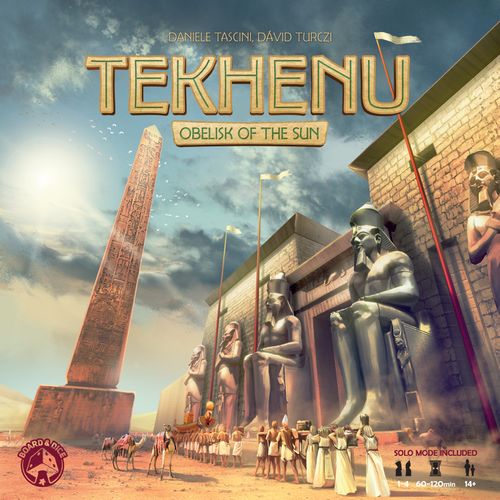
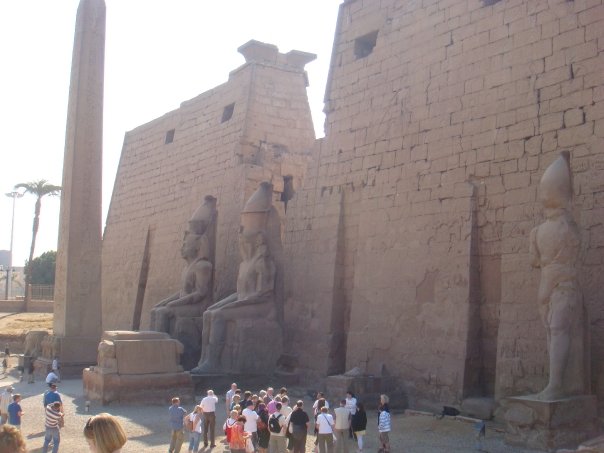
Gameplay Overview
In Tekhenu, players are Egyptian nobles and draft dice to perform actions that contribute to the construction of the Temple of Amun-Ra and the surrounding area, Ipet-Isut, which you may have heard referred to as Karnak.
Tekhenu is a nuanced game with complex rules. This is a general overview to provide context for the review, and not a detailed how-to-play. Some rules may be missing or glossed over.
Concept - The Obelisk
The most unique mechanism (and component) in Tekhenu is the central obelisk where dice are displayed. The obelisk wheel breaks the central board into six sections, each section belonging to an Egyptian god with an associated action.
The obelisk wheel has light, shade and dark sections that rotate with each round (mimicking the sun rotating around the obelisk). As each section changes from light to shade to dark (and back), the availability of different die also changes. Dice may be pure, tainted, or forbidden depending on the position of the “sun” and the color of the dice. The dice color represents a certain kind of good.
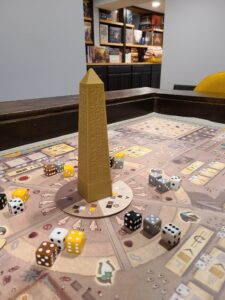
Note: One side of the obelisk disk has a reminder of which die are pure/ tainted/ forbidden during which phase. We somehow missed this the first three times we played, and had a rough go with setting up every time the obelisk rotated.
When players take an action, they choose either a pure or tainted die (shocker, they can’t normally take forbidden dice). The type of die is important during the Maat phase, where turn order is determined based on how well they “balanced” their pure vs. tainted dice values. More on that in a moment.
Game Flow
The game is broken up as follows:
2 Rounds → 1 Obelisk Rotation
2 Obelisk Rotations → 1 Maat Phase
2 Maat Phases → 1 Scoring
2 Scoring → End Game
Note: The rulebook has a very helpful suggestion for keeping track of where you are. Does everyone’s player board have 2 dice? Rotate the wheel. 4 dice? Do a Maat phase and check for scoring.
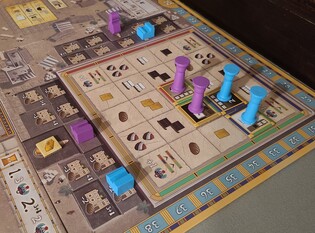
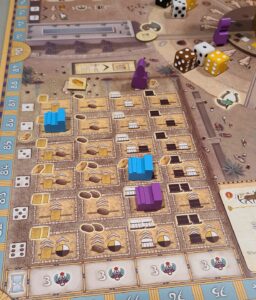
Round Overview - Player Actions
In a single round, each player takes exactly one die (pure or tainted) from the obelisk wheel. Each player chooses one of two actions for their die:
- Produce – gain as many resources as the die value
- God action – perform the action associated with the god
- Ra – construct a pillar in the temple complex
- Hathor – construct a building in the temple complex
- Bastet – advance happiness marker along the track
- Thoth – Gain cards for one time use benefits, on going benefits, and end game scoring
- Osiris – construct a workshop building to increase production ability
- Horus – construct a statue
- Statue for the gods – ongoing bonus when players select that god
- Statue for the people – gain gold and potential scoring opportunities
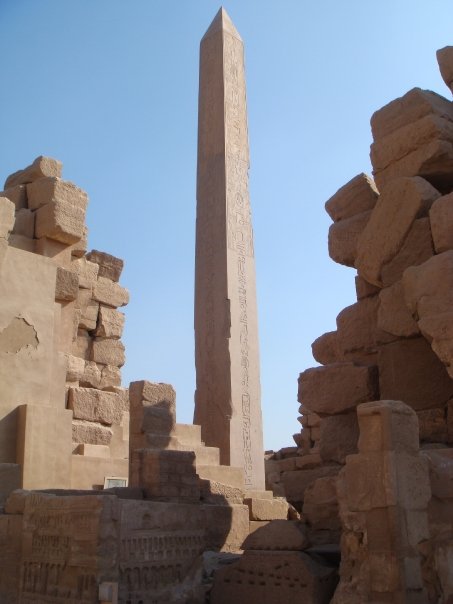
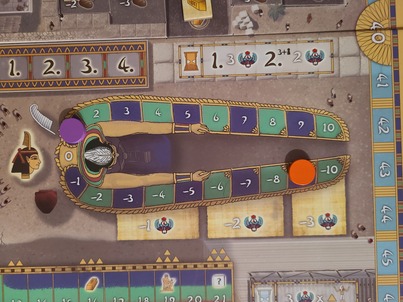
Obelisk Rotation
Check your player board – 2 dice? Rotate the Obelisk!
- Rotate the Obelisk
- Maat Phase (if its time)
- Scoring (if its time)
- Add dice to the shaded regions
- Adjust dice around the wheel based on new sun/ shade/ darkness
Maat Phase
Check your player board – 4 dice? Rotate the Obelisk, then do a Maat Phase!
- Count the total value of your pure minus tainted dice on your player mat (include any modifiers)
- Put your Maat phase marker on the tracker to indicate the difference between your pure vs. tainted
- Determine new player order based on who is closest to zero
- Put all the dice from the player mats back into the bag
- Finish up the Rotation (add/adjust dice on the wheel)
Scoring
There are a LOT of ways to gain points that are the same for the mid-game scoring and the end game scoring. We won’t go into all of them here, but essentially you rack up points for certain god actions – building in the temple district (Ra & Hathor), building in the workshop/ quarry district (Osiris), making your population happy (Bastet). You also get points during scoring from your player mat – increasing your “production” capability to the highest level & building statues/buildings.
End of Game
There are 16 rounds total, once you complete your final Maat phase you perform the end-game scoring. In addition to scoring the same god action and player board points as the mid-game scoring, players score up to 3 Decree cards that they accumulated at the beginning and throughout the game. There are also points for turn order, so keeping your board balanced for the final Maat phase is important!
But wait, there's more!
For brevity, we skipped or glossed over some important mechanics, which highlights how complex this game can be. We barely touched on the cards, which can improve or modify god actions, provide ongoing points for performing certain actions, and Decree cards which are essentially end game “goal” cards you can use to shape your strategy. We didn’t even mention scribes, which can be used to modify dice values or even as a “wild” action that ignores the location of a die.
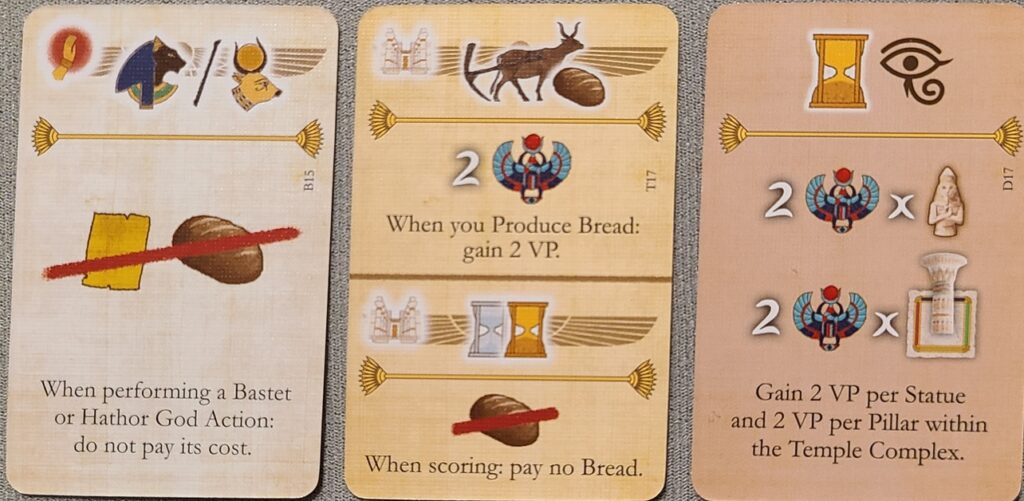
What do we think?
We were pretty confident going into it that Tekhenu would be a game we would like, and we were right. It has dice drafting, tight gameplay, and we love games where we have a lot of control over the outcome (limited luck). It plays very well at 2-player and now that we know how to play it only takes about an hour, meaning we can easily fit it in on a weeknight. We do have to complain a bit about the theme integration (like most Euros), but the overall gameplay and mechanics worked well for us.
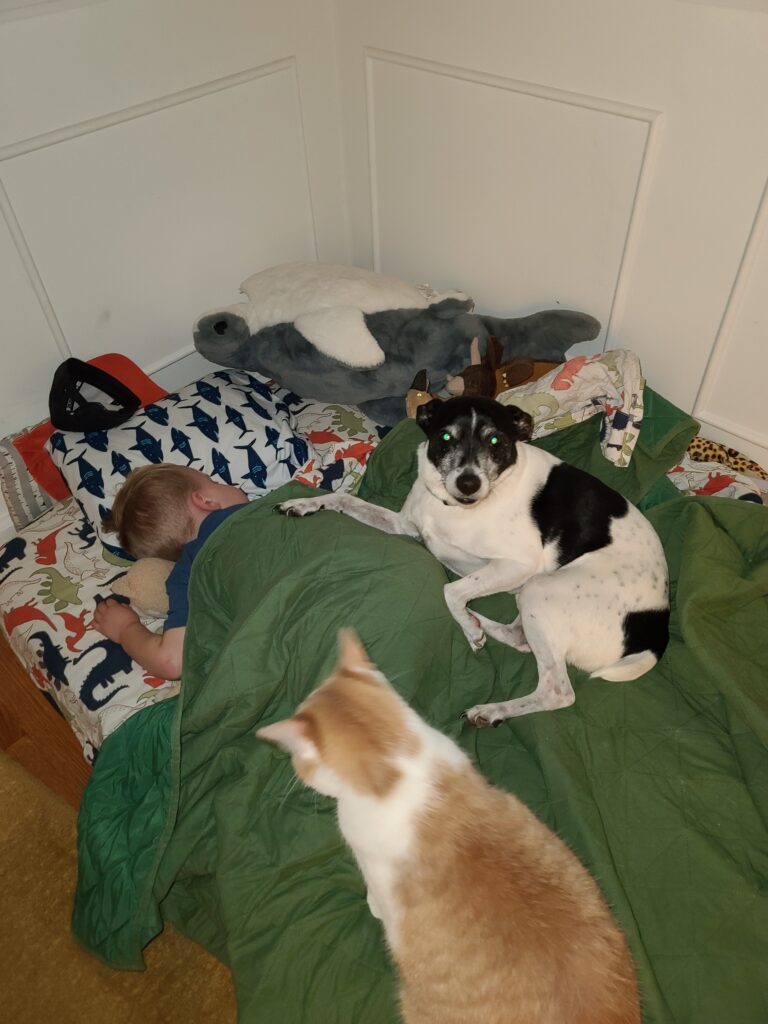
What did we like?
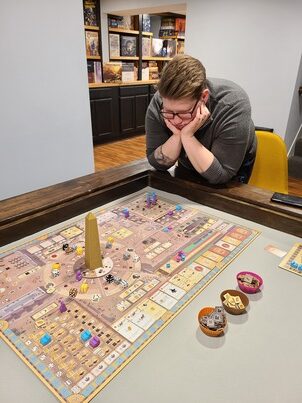
We often agree on games we like, but in general Emily tends to prefer sandboxy games (tons of choices, not much interaction), while Sarah enjoys more restrictive game play (butting heads over coveted actions). Tekhenu is a good balance of each. It’s definitely restrictive due to the dice availability, but in a way that seems to incorporate the best parts of a more “sandbox” game. There is no one path to victory (that we’ve found), and even when you get screwed over by your opponent(s), there is something else you can do that makes sense.
It also does very well at 2 players, which is tough to do for heavier games. You use less die and there are fewer spaces for certain types of actions, like building statues.
We also like that every play of Tekhenu allows you to try different strategies. You have to adjust to which die are available when and that means you can’t play every game the exact same way. That said, there are some things you can’t really ignore and expect to win, especially if your opponent is going for them. Decree cards are one of those things – if your opponent gets three that they can use for end game scoring, but you only have the one you started with, you’re going to have a really hard time making up the difference elsewhere.
There’s a ton of fun optimization to get the best out of each turn while keeping in mind which dice are currently available for your opponent to select and which section new dice will be added to at the next rotation. The dice distribution is random and throws a bit of luck into the mix, but it’s still done in a way that you feel you have a ton of control on the outcome of the game.
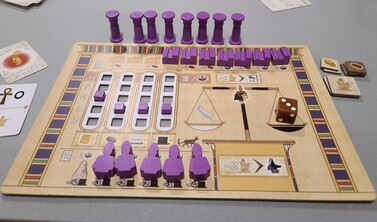
What didn't we like?
Biggest complaint has to be a common complaint with Euro games – the theme. A lot of Euros are great mechanics/gameplay that then get a theme slapped on as an afterthought, and this seems like one of those. Sarah is big into Egyptian history (including a month spent living in Egypt during college), but it only takes about thirty seconds of googling to see that the theme concept is pretty thin. The region the game is based on is known as Ipet-Isut (The Most Select of Places), now known as Karnak, was dedicated to a triad of gods – Amun, Murat, and Mut, none of whom are included in the game. The gods that were included were not known to be widely worshipped at the temple or the Ipet-Isut area. We can understand that the designers probably went with what they thought were the most well-known Egyptian gods, but it does seem like a fairly obvious and avoidable thematic oversight.
There are some relatively common moments that can feel a bit frustrating. Producing resources can feel like a wasted turn and there have been some games where the random dice distribution means there aren’t many great options, but that’s going to happen occasionally in any game that has dice rolling as an core mechanic.
Who will like this game?
Tekhenu shares a design history and inspiration with previous Tascini titles such as Tzolk’in: The Mayan Calendar and Teotihuacan. There are inevitably discussions to be had for how these games stack up to one another. For us, it’s hard to overcome how much we love Tzolk’in, but Tekhenu is a close second, edging past Teotihuacan for us.
Tekhenu can also be compared to a heavier version of other dice drafting games like Troyes.
Even though Tekhenu has a major emphasis on dice, it’s not a very luck-based game, so players who prefer a lot of luck or a great, immersive theme might not like it as much.
Sarah's Take
Tekhenu is a game I was instantly drawn to. The Egyptian setting and similarities to Tzolk’in are really what initially caught my eye.
I am also, like, really bad at this game. I tend to hyper focus on one thing and just get absolutely crushed when Emily is getting bonuses and VP for literally everything she does. In theory, this should tell me to get cards early on. But my brain is stuck in “must build statue” mode.
One gripe I have, which is not shared by Emily, is the reference card that is included with the game. I don’t know what it is, but I struggle with a lot of the fine details and little steps of each action in Tekhenu more so than other games of similar complexity. The included reference card just didn’t click with my brain. Thankfully, I did come across this player aide from BGG user Veector: https://boardgamegeek.com/filepage/207894/veectors-playerade. I personally recommend printing off at least one copy of this player aide. It’s especially useful for early learning games and for a quick memory jog when revisiting the game after not playing for a while.
Emily's Take
We’ve played this game exactly six times, and I have won five of them. So naturally, I love this game.
It’s more than just having a great time winning, I really enjoy games where there are many paths to victory, and Tekhenu definitely has a lot of different strategies I can test out. Each game I find myself trying something new, reacting to the dice placement and my starting Decree card.
Along with that, it’s also a game that rewards a multi-pronged approach. So far, I’ve found that getting fewer points from more places works really well for me, especially when I make sure I’m maximizing my Decree cards for that sweet end game bonus. Going for cards fairly early on can be a great advantage, too, especially the Technology cards that offer ongoing benefits for certain actions.
I didn’t struggle with the details of this game as much as Sarah, but there is definitely a higher barrier to entry due to the complexity of the game. Be prepared for 1-2 “learning” games before you feel like you’re able to make good decisions.
Rating Breakdown
Rulebook / Learning the game
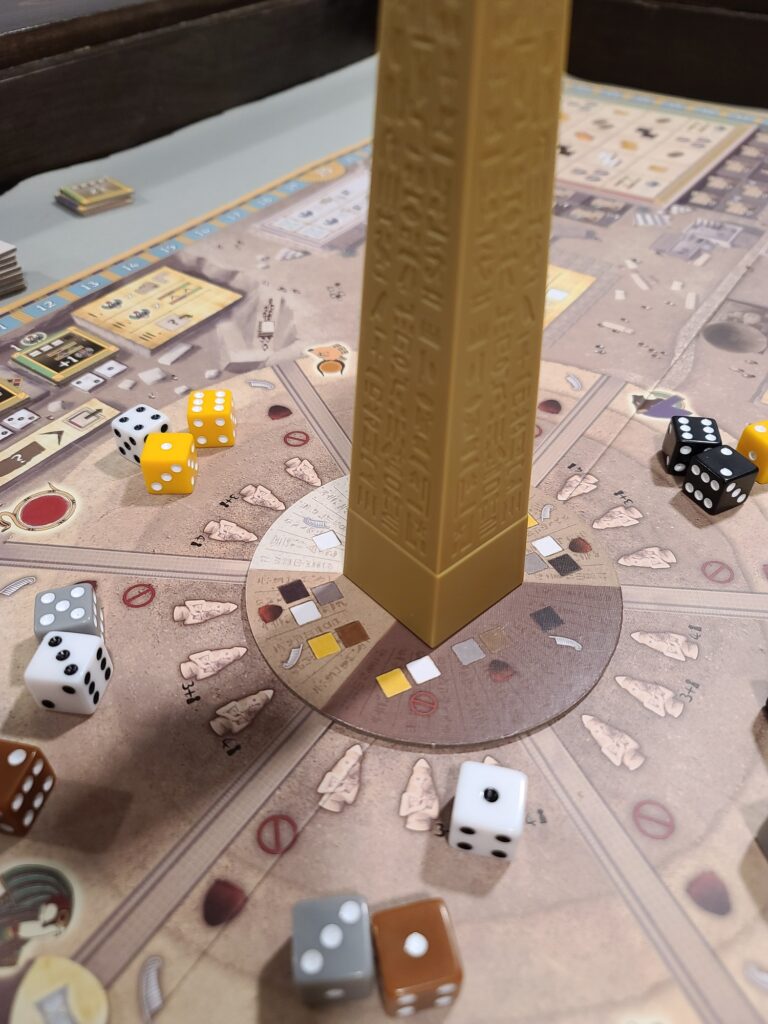
The rulebook is great, we learned from it relatively quickly. The rules themselves actually aren’t too bad when you’re first going through it. Remembering all the rules as you play, though, was really tough for us. Luckily, the rule book is fairly easy to navigate and so it worked for us as a quick reference when we forgot something. Sarah later found a great player aid mentioned above that also was helpful.
First Play
We entered our first play way overconfident that we understood the rules. The rulebook sort of made things seem straightforward, so we dove in quickly and struggled through. As with most games in this genre, there is a huge difference between getting the gist of gameplay and actually feeling like you’re making good decisions, and we definitely didn’t make good decisions the first (or second) time through.
Subsequent Plays
It probably took around three plays before either of us felt confident we could make good, strategic decisions. Four plays before we weren’t constantly referencing the rulebook or player aid. You might have an easier time if you play with someone who has played before. Definitely a high barrier to entry, but well worth it in our minds. There’s not much variability in setup, but the arrangement of dice and the different cards keep each game interesting so far. Because it’s such a mental investment to play, we don’t imagine we’ll play often enough to get bored of it anytime soon.
Parent Perspective
Interruptions
There is a lot of planning and strategizing involved in Tekhenu: Obelisk of the Sun. An interruption can potentially throw you off. But that being said, we have yet to get an uninterrupted play in and nothing went up in flames.
There is not a lot of player interaction in Tekhenu so if you’ve got to step away from the table, it’s best to do so immediately after taking your turn so others can take their turns and finish the round. This may put the person stepping away from the table at a disadvantage, however, as strategy and planning for future turns needs to be fluid in the event someone takes a die you were planning to use on an upcoming turn.
Pro Tip: The counting the dice on your player board thing is great advice from the rule book. If the whole game gets interrupted and no one can remember where you left off, count everyone’s dice!
Time Investment
Sorry, everyone, but we don’t have an accurate estimate of this, since we have yet to play a game without significant toddler interruptions (6 plays, all of them with potty breaks, frantic searches for his “babies”, or absolutely NEEDING to tell us again that he wants the PJ Masks dinosaur set for Christmas). Yet, even with those breaks, we are still able to get a game played in about 90 minutes – 2 hours. We could probably get a two player game in right around an hour now that we are comfortable with the game.
Set up and clean up seem like a lot at first, but it’s really not bad for how heavy the game is. The biggest part of set up is setting up individual player mats. Set up takes maybe 10 minutes as long as we put it away neatly the time before.
Life Fit
Tekhenu falls right on the line of a weeknight vs weekend game for us. Learning games and early games before we were entirely familiar with the actions and strategy pushed the time limit of a weeknight game for us (plus kid interruptions). Now that we know what we are doing we can confidently play on a weeknight.
Rating
7.5/10
Tekhenu: Obelisk of the Sun is a great game for players who enjoy medium-heavy, strategy-intensive games with a lot going on. Interruptions can cause minor disruptions but nothing game breaking. We knocked it a bit for the halfhearted theme, but it’s still nice to see a Euro-style strategy game with a non-medieval/idyllic countryside theme. Playtime will decrease as familiarity of the game increases, but each play only got better as we became more familiar with the mechanics and strategies.
*See our rating scale HERE
Click through for more posts, or follow us on social media to see what we’re playing and for new post updates!

Pingback: Top Games of 2020 - Two Moms Game